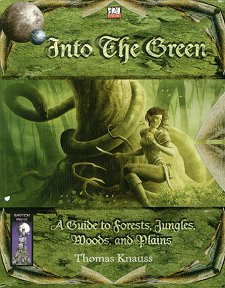
Aimed primarily at DMs - although also useful to players whose characters are Rangers, Druids or otherwise interested in 'the great outdoors' - this book describes some of the environments in which wilderness adventures can take place.
Most of us, even city dwellers, have some idea of what a forest or a plain would be like back in the pseudo-mediaeval days of the usual fantasy setting. A bit wild, uncultivated, limited roads (read 'tracks'), few inhabitants and plenty of wild animals. This book sets out to explain what it's really like, wandering through this kind of environment perhaps for days or weeks on end. How will characters survive? What will they eat? What might they expect to encounter?
In these pages, you will find a dense mix of 'real world' and fantastical ecology. Each chapter begins with an overview of the environment in question, and then details several imaginary plants and animals that you might encounter there. Each is well-described, with information about their ecology, how you would be able to make use of them in a survival situation as well as what harm they might be trying to do you, and how they engage in combat. The climate is also covered, so you know what sort of weather conditions to expect.
The four environments considered are - as described in the sub-title - forests, jungles, woods and plains. The forest is the pristine virgin growth, a botanical climax of flourishing life in resource-rich, well watered ground. This is what you find covering temperate lands that have not yet been exploited by humans... or in the fantasy setting, humanoids. The jungle is the equivalent grown in tropical areas. Woods are interesting - they are at least semi-civilised, the interface between primordial forest and cultivated lands. They still pose dangers to the unwary and - by their nature and location - are more likely to be visited by virtually all adventurers at some point in their careers, unless they flatly refuse to leave the city walls! Plains are again lush and fertile, but serve as a transition between the abundance of forest or jungle and more arid parts of the world such as deserts.
The fifth chapter of the book covers 'wilderness equipment' - both that which it would be useful to take with you and that which can be created utilising the resources to be found there. This is particularly fascinating, because it could be used as a reason for visiting such areas - to collect or trade in useful items - or at least a profitable sideline if other concerns take you there. There are also some magical items relevant to wilderness situations, but the most useful parts are the 'new materials' selection - things you can acquire during your travels such as animal pelts and specialist woods - and an associated collection of 'new substances' that might be of interest to herbalists and alchemists - drugs, pigments, poisons and even glue and sunscreen! Many of the resources described are also of interest to spellcasters, as material components or for use in the creation of magical items.
Finally, there's a collection of spells, mostly aimed at control of or protection from natural dangers. There is even a spell to relieve allergic reactions and, for the more nasty-minded, one which causes anaphylactic shock in its target. You can create a magical storm cellar in which to take refuge, or use the ford spell to create an instantaneous bridge to get across a river.
There are several Appendices: naturally-occurring poisons, encounter charts for the various environments (including random plant-finding for use if the party botanist asks what he can see!), and a basic weather system. These are all useful for chance encounters and descriptions of what's going on around the party as they travel, although if weather, creatures or plants are actually important it's probably worth planning in a bit more detail before running the wilderness exploration.
Overall it's a very useful book, especially if you want to run wilderness exploration adventures. Even if the overland bit of your scenario is intended just as a journey from A to B, with the events in A and B being the important stuff, it's nice to have some tools to make the travelling time come alive. How often have a party of adventurers been told it's three days' travel to the wizard's tower or whatever, and barring a couple of fights with bandits or wandering monsters, just, well, got there? This book gives the DM some tools to add realism to their alternate reality... it's not just a string of encounters linked by your plot, but a living, breathing world in which the player characters exist and interact. Most of it you'll need to read through and plan ahead, but once you know what's where in your world, the 'bits in between' ought to come to life.
Return to Into the Green: A Guide to Forests, Jungles, Woods and Plains page.
Reviewed: 23 October 2005

